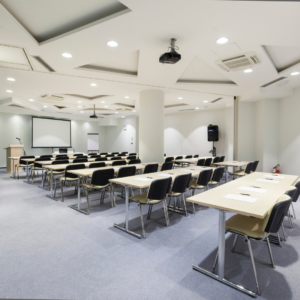 Educational facilities, including schools and universities, are more than just physical structures. They are dynamic spaces that facilitate the process of learning and growth. As such, maintaining these facilities is important not only for the safety and comfort of students and staff but also for enhancing the overall educational experience.
Educational facilities, including schools and universities, are more than just physical structures. They are dynamic spaces that facilitate the process of learning and growth. As such, maintaining these facilities is important not only for the safety and comfort of students and staff but also for enhancing the overall educational experience.
Regular inspections along with preventative measures are important facets for maintaining educational facilities. Spaning from cleaning gutters and downspouts to prevent water damage, changing air filters to ensure proper ventilation, and trimming trees and shrubs to keep them away from buildings.
Here’s a look at how Intaus Group assist in maintaining educational facilities and areas you need to consider to keep your facility running smoothly.
Understanding the Scope
Facilities management in an educational context encompasses a wide range of activities. These include routine maintenance, safety checks, space optimisation, energy management, and landscaping. The goal is to ensure that the physical environment is conducive to learning, is safe, and well-maintained.
Routine Maintenance
Routine maintenance involves regular checks and repairs of the physical infrastructure. This includes plumbing, electrical systems, heating and cooling systems, safety features and structural elements. Regular maintenance helps prevent major breakdowns and ensures the longevity of the facilities. More specific items that should be checked are:-
- HVAC Systems and Ventilation: Ensuring student comfort and well-being relies on effective heating, ventilation, and air conditioning (HVAC) systems. Maintaining HVAC units regularly, clean filters, and promptly attend to any arising issues.
- Electrical Systems: Regularly inspect electrical panels, wiring, and outlets. Address any faulty wiring or electrical hazards. Also ensuring that classrooms have adequate power outlets for modern technology.
- Plumbing and Restrooms: Regularly check plumbing fixtures, toilets, and sinks. Address leaks, clogs, and water pressure issues. Maintain clean and functional restrooms for students and staff.
- Flooring and Carpets: Regularly clean and maintain flooring. Address any damaged tiles, loose carpeting, or slippery surfaces. Properly maintain gymnasium floors to prevent injuries during physical education classes.
Safety Checks
Safety is paramount in educational facilities. Regular safety checks should be conducted to ensure all safety equipment, such as sprinkler system, fire extinguishers, emergency exits and alarms, are in working order. Additionally, facilities should comply with health and safety regulations, including accessibility standards and hygiene requirements.
Technology Integration
 Technology has become an integral part of modern education. Many schools have already moved down the path of integrating technology into their facilities, such as providing access to computers and high-speed internet, creating interactive classrooms with smart boards and projectors, or implementing online learning platforms. This not only enhances students’ learning experience but also prepares them for the digital world outside of school. Much of this technology required regular updates and maintenance, making it a continuous effort for schools to stay current with the latest advancements.
Technology has become an integral part of modern education. Many schools have already moved down the path of integrating technology into their facilities, such as providing access to computers and high-speed internet, creating interactive classrooms with smart boards and projectors, or implementing online learning platforms. This not only enhances students’ learning experience but also prepares them for the digital world outside of school. Much of this technology required regular updates and maintenance, making it a continuous effort for schools to stay current with the latest advancements.
Collaborative Learning Spaces
Collaboration and teamwork are essential skills that students need to develop. Therefore, schools are incorporating collaborative learning spaces into their designs. These spaces allow students to work together in teams on projects or assignments, encouraging communication, critical thinking, and problem-solving skills. Collaborative learning spaces often include comfortable seating arrangements, whiteboards or chalkboards for brainstorming ideas, and technology like tablets or laptops for research and presentations.
Space can become an issue with these spaces and usually involves rearranging furniture to facilitate better interaction, creating multi-purpose spaces, or even repurposing underutilised areas. A well-optimised space can enhance the learning experience and accommodate more students comfortably.
Environmental Sustainability
Educational facilities have a responsibility to promote environmental sustainability. This can be achieved through measures such as using energy-efficient lighting and appliances, installing solar panels, promoting recycling and waste reduction practices, and incorporating green spaces into the design of the facility. By setting an example for students, schools can educate future generations on the importance of preserving our planet.
Energy Management
Energy management is crucial for reducing operational costs and promoting sustainability. This along with our environmental sustainability can involve implementing energy-efficient lighting, optimising heating and cooling systems, or even installing renewable energy sources like solar panels.
Landscaping
 The outdoor spaces of educational facilities also need attention. Landscaping not only enhances the aesthetic appeal of the facility but can also provide additional learning opportunities. For instance, a well-maintained garden could serve as a learning space for biology lessons.
The outdoor spaces of educational facilities also need attention. Landscaping not only enhances the aesthetic appeal of the facility but can also provide additional learning opportunities. For instance, a well-maintained garden could serve as a learning space for biology lessons.
Maintaining educational facilities is a multifaceted task that requires a proactive approach. By prioritising routine maintenance, safety checks, space optimisation, energy management, and landscaping, Intaus Group can ensure that schools and universities are not just buildings, but vibrant, safe, and inspiring spaces for learning.
If your educational facility is looking for a team of experts to ensure the smooth running of your school or university get in contact with Intaus Group for a free no obligation quote.